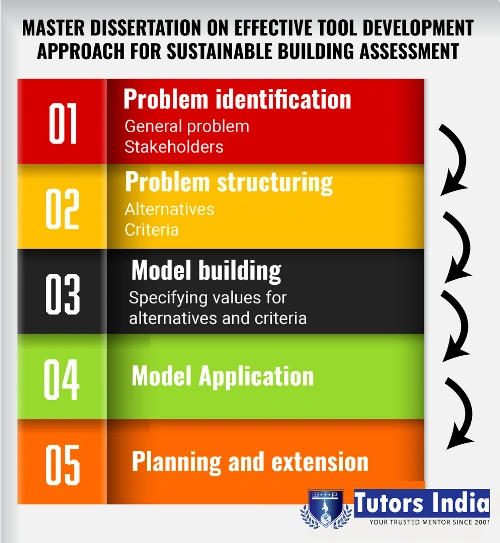Master Dissertation on Effective tool development approach for Sustainable building assessment
Introduction
The term “sustainable development” means “intense focus on standard of living,” allowing people to live in a healthy ecosystem while also trying to incorporate constant improvement of living circumstances, financial and ecological issues for present and future decades.
As a result of this understanding, society now considers the construction industry to be a major cause of environmental impacts. This viewpoint considers the apparent inordinate resource consumption and environmental damage source during the building projects and use phases.
Green Buildings
When certain conditions are met, green buildings produce concrete outcomes. These include minimizing ecosphere disruptions and other advancements all through life cycle, as well as optimizing the efficiency of power performance and organizational effectiveness, which leads to a reduction in risks to human and environmental health. Green building encourages the advancement of the municipal, provincial, and worldwide ecosystems during building projects and use, as well as optimizing resource planning and organizational effectiveness while minimizing risks to human health and the environment.
Environmental Assessment Tools
BREEAM, LEED, SBTool, and CASBEE are the most prominent and frequently used environmental assessment techniques in the world. It recognizes common threads and differentiation in order to facilitate the incorporation of environmental requirements into prospective new strategies.

BREEAM: BREEAM has established a foundation for best practice in sustainable design, propelling it to become the most effective scheme in the world for measuring and describing a building’s environmental performance. BREEAM employs a scoring system that was developed through a nationwide deliberative approach. The assessment compares important issues with dependable practices and achievement levels, after which credits are given in ten groups. Each categorization has a distinct list of conditions, with pre-weighed credit facilities that can be self – reinforcing or based on merit against certain defined requirements, such as Standard Assessment Procedure. These points are then added up and produce a “single total rating on a magnitude of Pass, Good, Very Good, Excellent, and Outstanding. Tutors India has vast experience in developing dissertation topics for student’s pursuing the UK dissertation in business management. Order Now
LEED: LEED is a voluntary certificate program that was created through a consensus process that involves main players in order to gain a complete, simple approach for evaluating performance of buildings and having to meet sustainability goals.
SBTool: SBTool, formerly known as GBTool, is divided into four levels, with the elevated amounts logically deduced from the weighed agglomeration of the lower ones, employing one goal, seven issues, and 29 categorizations. In order to identify the future dissertation topics, we have reviewed the dissertation (recent peer-reviewed topics) on both engineering and management. Order Now
This is intended to allow users to reflect the represent important, innovations, building customs, and cultural norms that exist inside the numerous countries and regions participating in the evaluation process. As a result, national teams improve its baselines and strength training using multiple techniques such as the analytic hierarchy process (AHP). Each achievement issue’s criteria and sub-criteria are scored on a linear scale ranging from -2 to +5.
CASBEE: CASBEE is defined as a “joint government, academic and industrial sector approach used in Japan.” You will find the best assignments for future researchers enrolled in engineering and Management. These topics are researched in-depth at the University of Glasgow, UK, Sun Yatsen University, University of St Andrews and many more. The four main facets of CASBEE are power efficient, economization, environmental systems, and indoor air quality, which constitute a total of 80 sub-criteria that are further classified into two major groups: Q (Quality), and L (Local Environment) (Loadings). In order to evaluate the long-term viability of green buildings, CASBEE uses the BEE (Building Environmental Efficiency) value, as shown in the formula below:
Building Environmental Efficiency Equation
CASBEE is distinguished from other assessment methods by its distinct approach to the completion of its final result. Instead of depending on a simple additive approach, CASBEE presents the idea of Building Environmental Efficiency (BEE) with weighting coefficient values for the examination of different types of buildings. These are depending on the outcomes of a survey questionnaire of various stakeholders such as developers, property owners, and contractors, which are then, evaluated using an analytic hierarchy process.
Conclusion
These assessment tools, as an important component of the sustainable construction delivery system, are laying the groundwork for the construction sector’s long-term viability. Certain classifications regarded in both SBTool and CASBEE, such as financial implications and quality of service, have been consolidated in the prospective future scheme, including the most essential ecological categories assessed by BREEAM and LEED. This assimilation seeks to achieve supremacy by taking into account the most dependable criteria for reflecting and diagnosing sustainability impact, as well as to promote a smooth transition to more sustainable practices such as renewable power, green architecture, and rainwater catchment systems. Contact Tutorsindia for Tool development research work.
Reference
- Alyami, S. H., & Rezgui, Y. (2012). Sustainable building assessment tool development approach. Sustainable Cities and Society, 5, 52-62.
- VillarinhoRosa, L., & Haddad, A. N. (2013). Building Sustainability assessment throughout multicriteria decision making. environment, 7(9), 11.
- Bragança, L., Mateus, R., & Koukkari, H. (2010). Building sustainability assessment. Sustainability, 2(7).
- AlWaer, & Kirk. (2012, December). Building sustainability assessment methods. In Proceedings of the institution of civil engineers-engineering sustainability(Vol. 165, No. 4, pp. 241-253). Thomas Telford Ltd.

 Previous Post
Previous Post Next Post
Next Post